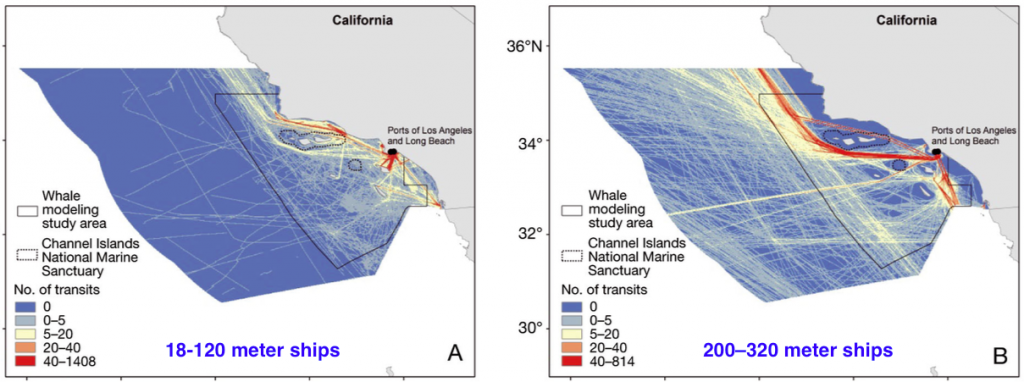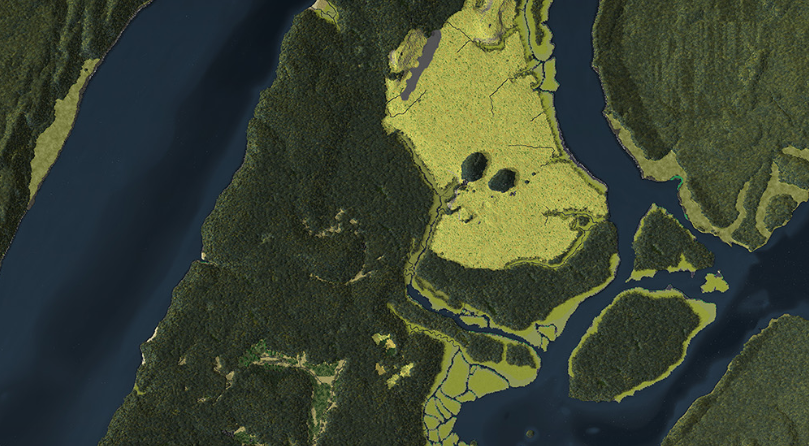Apr 28 2017
AEI lay summary of
Redfern JV, Hatch LT, Caldow C, DeAngelis ML and others (2017) Assessing the risk of chronic shipping noise to baleen whales off Southern California, USA. Endang Species Res 32:153-167. https://doi.org/10.3354/esr00797 (open access)
A paper published earlier this year (on my birthday; what a nice present!) takes a close look at shipping noise levels along the Santa Barbara/Los Angeles coast, with particular attention to key habitat areas for several whale species. This region of offshore waters includes crucial feeding zones on the edge of the continental shelf, as well as the Channel Islands National Marine Sanctuary; meanwhile, some of the shipping traffic headed into the port of Long Beach (near LA) passes between the Sanctuary and the coastline.
The pictures generated by the authors surely qualify for the thousand-words designation, so I’ll let these key graphics tell most of the story—you can click any image to see a larger version. First up, here’s the number of ship transits occurring in these waters over five months (August to November 2009):

Next, here’s how the accumulated noise of all these ships translates into sound levels. The researchers modeled the sound levels at two different frequencies; this is because the 50Hz band is especially important to blue and fin whales, while the 100Hz band is most important to humpback whales. Note that at both frequencies, there are some areas that remain relatively protected from the worst of the shipping noise. Read the rest of this entry »
Apr 28 2017
Despite the noises coming from the Trump administration and Alaska’s elected officials, it appears that any new initiatives to expand offshore oil and gas development in the Arctic will be falling on deaf ears among fossil fuel companies.
“We think there is almost no rationale for Arctic exploration,” Goldman Sachs commodity expert Michele Della Vigna said in late March. “Immensely complex, expensive projects like the Arctic we think can move too high on the cost curve to be economically doable.” Indeed, unless oil again approaches $100 a barrel, these areas are likely to be ignored; just last year, oil companies gave up on hundreds of leases in the Beaufort and Chukchi Seas that they had spent $2.5 billion to acquire back when prices were high enough to justify their plans there.
Despite President Trump’s oft-repeated pledge to open up America’s “vast untapped domestic energy reserves,” the fact is that even without the offshore Arctic or the Atlantic coast (both excluded from new leasing from 2017-2022 by the Obama administration), the areas already open to offshore development “make available more than 70% of the economically recoverable resources, which is ample opportunity for oil and gas development to meet the nation’s energy needs.”
UPDATE, 4/28: Just after writing this, notice of the latest Trump Executive Order crossed my desk, this one
explicitly targeting the offshore areas removed from the 2017-2022 lease sales by Obama’s team. Meanwhile, Alaska Senator Lisa Murkowski
introduced a bill to re-open Arctic waters; and for added freakiness factor, a NC Congresswoman has introduced a bill to force a lease sale within a year, and exempting this effort from NEPA (ie EIS) provisions for five years! If any of these proceed into action on leasing, no doubt a court challenge will ensue, centered on the presumed non-reversibility of Obama’s last-month actions.
UPDATE, 5/2: This is encouraging news: the Supreme Court has
declined to hear an appeal of a lower court ruling that upheld the US Fish and Wildlife Service’s designation of a vast area of the Alaskan ice shelf as critical habitat for polar bears. The oil and gas industry argued that its short-term activities should not be limited by concerns over longer-term global warming; ie that their ships, drilling, etc. are not in and of themselves responsible for any global warming. The lower court ruling is not necessarily based on on the idea that oil and gas development should be stopped in the name of climate caution; rather, it simply upholds the FWS contention that the ice shelf is threatened by warming, and that this habit should be spared further intrusions in order to maximize the chances that the polar bears can survive. It’s reassuring that the current Supreme Court was not interested in pushing back against such climate-driven policies.
Apr 28 2017
With apologies to Stevie Wonder and to all my college buds who revel in “skyscrapers, and everything!”, I gotta say that THIS is what puts me in a New York state of mind:
 Wow indeed. As Eric Sanderson, author of the eye-opening 2009 natural history book Mannahatta, says, “If Mannahatta existed today as it did then, it would be a national park—it would be the crowning glory of American national parks.” More biodiversity per square mile than Yellowstone; more birds than the Great Smokies.
Wow indeed. As Eric Sanderson, author of the eye-opening 2009 natural history book Mannahatta, says, “If Mannahatta existed today as it did then, it would be a national park—it would be the crowning glory of American national parks.” More biodiversity per square mile than Yellowstone; more birds than the Great Smokies.
Now, in addition to Sanderson’s compelling graphic representations of the primal landscape of this “island of many hills,” we can also revel in an aural taste of what once was. Calling Thunder is a multi-media and VR project put together by a former NPR audio engineer and an NYU School of Visual Arts grad student, and it’s lots of fun to explore.
The presentation is centered around an almost ten-minute video (also broken into smaller, location-specific chunks) that takes us through four locations in the modern cityscape and back in time to hear a bit of what these locations sounded like when they were a wilderness of forest, pond, shoreline, and rocky outcrops. Utilizing sounds from Cornell’s Macauley Library of Natural Sounds, each location is also recreated in a longer binaural audio track that lets us go a bit deeper in to these ancient soundscapes. Also check out this recent NYT article to learn more about the project and hear from its creators.
It’s actually not all that surprising that this island at the mouth of the Hudson would have been home to such a rich and concentrated profusion of wildlife. That’s what woodlands, marshes, and rivers will do for ya. Next, I’d love to see and hear something like this for the big-city landscape that has most enticed my time-traveller longings: the San Francisco Bay area and Sacramento delta….


